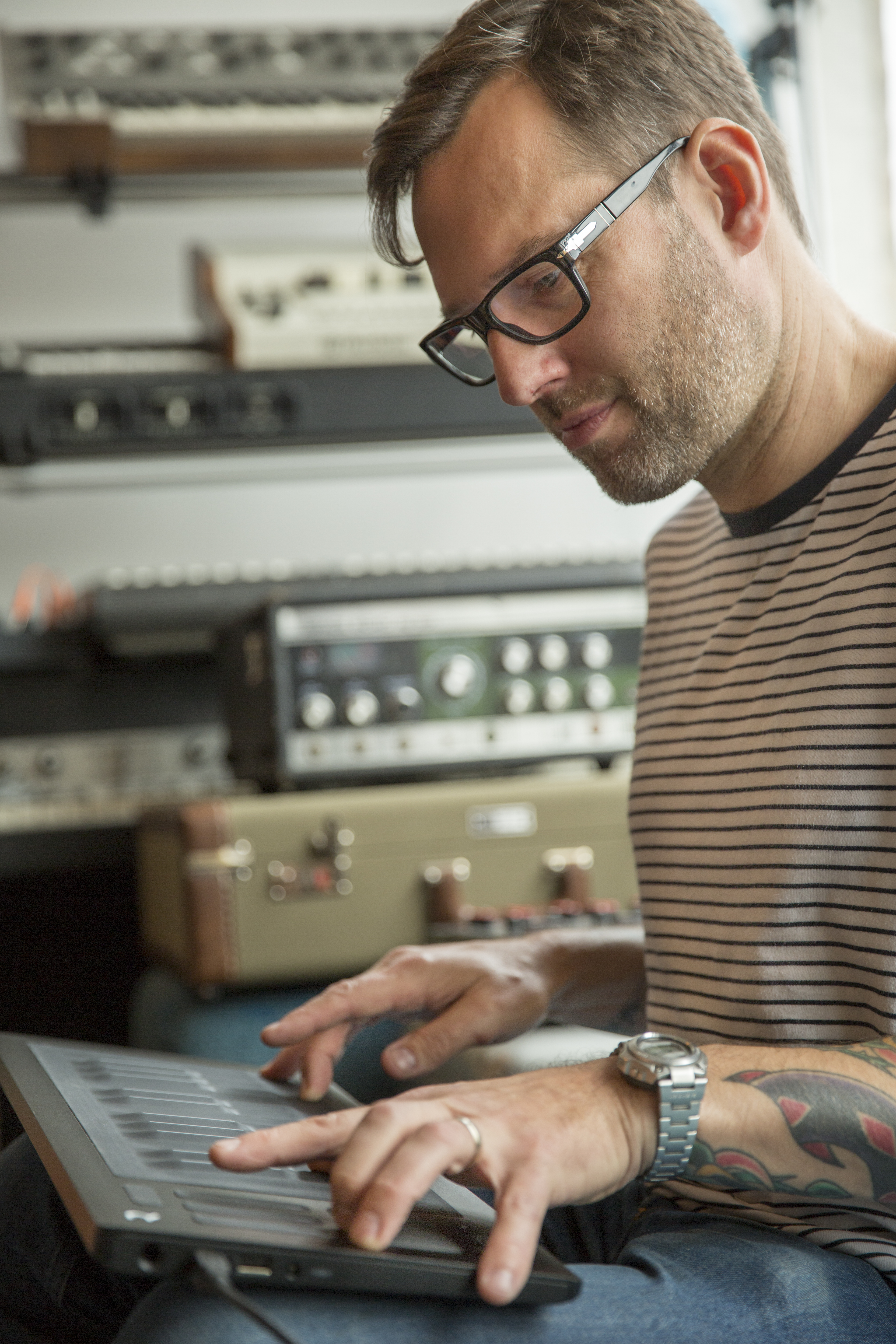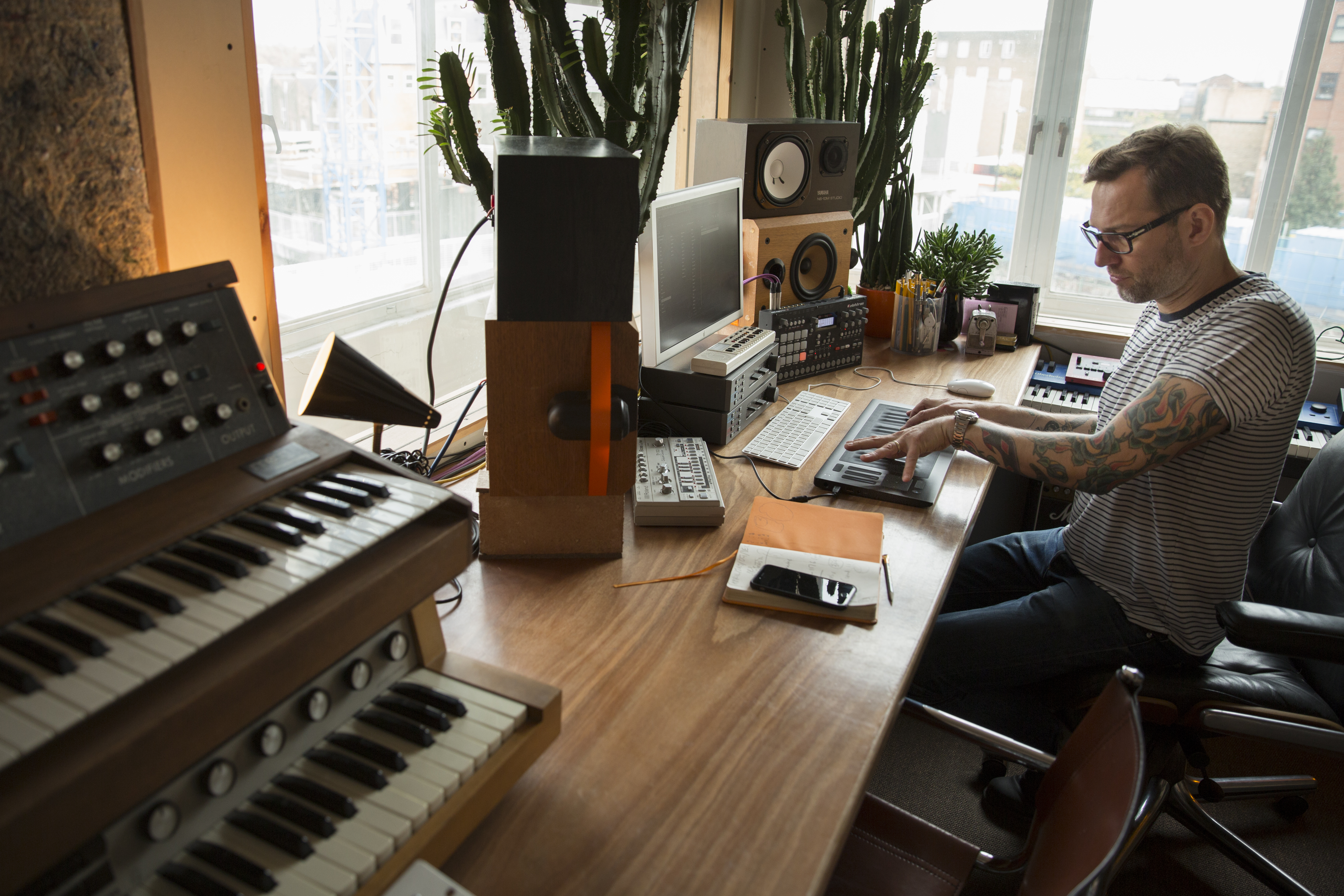Liam Howe and his Ten-Finger Orchestra
Creating orchestral soundtracks in East London with the Seaboard RISE
Liam Howe is using a Seaboard RISE 25 to create a new orchestral soundtrack for Alain Resnais’s 1961 cinematic masterpiece Last Year in Marienbad. It is one of the quirkier projects underway for the renowned producer, songwriter, and member of the Sneaker Pimps, the 1990s cult band. A fan of Seaboards since the release of the GRAND, Liam talks about bringing the RISE into both his East London studio (where it sits amid a pantheon of synthesizers dating back to the Minimoog) and on to the stage, as Sneaker Pimps prepares its long-awaited new album.
ROLI: This is an impressive studio. Do you actually use this Minimoog for your work?
Liam Howe (LH): Of course! I’ll show you. For those big throbby basslines, the Minimoog still does it best. It’s curious how it sounds very old, even though it’s a synthesizer. Everyone still thinks that synthesizers mean “modern” – the future. If an A&R guy is working with a band that doesn’t use synths, he’ll say: ‘We need to modernize this record. Let’s put some synths in it.” But you know, they’ve been around since the 1960s – since this Moog here. It’s an old technology. And that puts electronic music in perspective.
ROLI: You have electronic and digital instruments of all sorts in this room. Now here’s another – the Seaboard RISE. Do you see your RISE as replacing some of these other synths? Or is it just another instrument in your ensemble?
LH: It’s an entirely new addition. It’s a genuinely new instrument, and that’s its strength. I may go to my Moog for some throbbing bass or the SPV for some digital bendy sounds. But the RISE makes you play it in a way that doesn’t sound like your other synths. It can be a guitar or a flute … or it can sound like a synth.
ROLI: Where have you found it most useful?
LH: It’s still early days integrating it in my setup, but where I’ve found it invaluable is in soundtrack scoring. It’s amazingly responsive for film work when you’re writing to picture. You’re watching the screen – the running of the film – and your DAW is right there, and without having to take your hands off the keyboard, you can watch and compose at the same time. It’s like being a conductor. Your fingers are conducting the orchestra. You can see the tension rising in the film and … [Liam proceeds to improvise a darkly atmospheric track]. It’s the most intuitive approach you can have for a soundtrack.

You can do this to an extent on a normal keyboard, but the RISE suits film scoring so precisely because you can put these minute nuances into your playing – maybe put in a bit of pressure for a swell, or make minute adjustments to pitch. For something like a glissando, there’s no comparison. Previously if I wanted a big chunk of strings glissando-ing up to a single note, it would take me a good 20 or 30 minutes to program that. I would need to set up eight tracks and put in raw pitch-bend information for each one. And at the end of all that programming, it would not even sound natural – it would sound a little too calculated.
On a Seaboard I can do it all in real time, and it sounds natural because I can play a little off key, just like a 30-piece string section where each instrument is tuned slightly differently. It is these microtunings that simulates the polyphonic expression of what an orchestra really sounds like. So what it’s giving me is flexibility and expression in real time. I save time in my work, and then on another level I just think of things I just wouldn’t think of otherwise if I was spending an hour writing it into a program, rather than playing it on this keyboard.
ROLI: So this piece of kit is actually changing the way you compose?
LH: Yes! The way that I can feel it now, it means I can compose my strings in a much more organic way that’s similar to how it would be with an orchestra. Similarly with percussive sounds, it means I can bring in sounds that just aren’t possible on another keyboard, because keyboards are quantized to a western scale and many percussion instruments are not. You just wouldn’t play an African log drum, or gamelan bells, on a keyboard, because you’d hear it quantized to a western scale, and those instruments are just not tuned that way.
But the Seaboard takes us to this new extreme of almost fluid tonality, and suddenly things are way more interesting. We’re liberated from the quantization of pitch. You can bend all over the place, and then snap back into western tunings when you like. The idea of bringing microtonality back into music again is very exciting for me.

"We’re liberated from the quantization of pitch. You can bend all over the place, and then snap back into western tunings when you like. The idea of bringing microtonality back into music again is very exciting for me."
ROLI: Tell us about a project that you’re working on right now with your RISE.
LH: I’m about to start working on a new soundtrack for Last Year in Marienbad. I’m getting actors to redub the film in English, and I’m stripping out all the sound and writing an entirely new Seaboard soundtrack. I’ll be watching the film frame by frame and composing with my Seaboard RISE as I go along.
ROLI: Why that film?
LH: In techno culture around the New Romantic period, people like Ultravox were obsessed with it, even though it was made in the 1960s. It’s probably the most influential modernist film ever made. In its cinematography and structure it’s a visual template for a lot of modernism, in that it’s all about repetition and difference. The visuals are so forward-looking, yet the soundtrack locks it in the past; it’s so overly nostalgic. So I want to bring a 2016 auditory experience to this historical film. And I’d hope the effect is huge among the people who care about Last Year in Marienbad, because I think the soundtrack is at least half the experience of a film.
ROLI: What are your views on the Seaboard RISE as a performance instrument for the stage?
LH: Well, I’m using it on the new Sneaker Pimps record which will come out later this year, and then we’ll be touring and the RISE will be on stage. When you’re touring with a band, it’s really frustrating how little a keyboard can do. You get bored doing the same thing every night. So the idea of having something so expressive up on stage would mean you could have so much more fun! Keyboardists are usually in the background nodding their heads, while the guitarists get to bend all over the place and jump around. So the RISE could give the poor keyboardist some stage presence for once! I’m sure someone’s going to make a keytar-like chassis for it at some point. Surely someone wants to play it like that live.

ROLI: In its first year on the market, do you see the RISE becoming more popular as a tool for performance or production?
LH: Production, because producers tend to be more adventurous than artists. In a studio a new tool, a new toy, is everything, whereas live performance is all about having equipment that’s totally predictable and reliable, and it will simply take a while before people learn the Seaboard to a level where they are comfortable performing live. I can see people becoming real virtuoso performers on the RISE, just like on any new instrument, but it will take dedication. Imagine if the first cello came out today. People would look at it and say, “Well how’s this going to work?”
ROLI: Why do you think there have been so few new musical instruments in the past few decades?
LH: I don’t know, I often wonder this myself. It’s a shame that there hasn’t been more innovation. Pan Drums came out over ten years ago … The last really big new thing was the synthesizer, and that’s 50 years old. It may sound counterintuitive because the public sees music as so forward and experimental, but the music world is really rather conservative, especially in instrumentation. We’ve gotten to a place where we’re comfortable with what’s out there, and many people don’t see the need for something new. Most of the pop music we make is still three minutes and thirty seconds, has three choruses, and is in the western scale. In pop music it’s like we’ve drawn a big perimeter fence, and there’s no expansion of this fence. We just keep banging around inside of it, permutating inside of it, mixing bits from the ‘90s with something from this year.
If we can break out of the western scale, we have the chance of seeing something really new happen. I love what’s new. As a producer I’m primarily in love with sound, so for me playing a new instrument like the RISE is not an alien experience that challenges my sense of what an instrument should be. It’s more like: “Now I can do ten more things with sound that I couldn’t do before!”
ROLI: What do you think of the new Seaboard RISE 49?
LH: I love the 25-keywave RISE because it fits easily on my desk. Anything bigger I would have to put under the desk. But the RISE 49 is perfect for performing. I think anyone in a band who plays it both in the studio and live – they’ll go for a 49. The Seaboard GRAND is for someone who’s really great at performing, and that’s not me, so I’d go for a 49 on stage myself.
ROLI: How exactly are you using your RISE for the new Sneaker Pimps album?
LH: As much as I can! It’s early days. I’m just starting to chew on Equator and get some new sounds. I’ve always been a huge fan of pitch modulation, so the ability to create these pitched moments is great. The album comes out at the end of this year, and it’s difficult to say until I’ve done it. I’ll probably end up making loads of my own sounds on the RISE.
ROLI: We’re looking forward to hearing the new album – and maybe getting a Liam Howe sound pack!

If you have not yet heard the Sneaker Pimps, check out the video of their 1997 hit Spin Spin Sugar from 1997. Liam is the guy on the bed in the opening shot. A lot of fans have been waiting ten years for a new album:
undefined
And for something completely different, this is the original soundtrack of Alain Resnais’s film Last Year in Marienbad. Tinny, fusty organ music dominates the film, musically reinforcing an atmosphere of anxiety and disorientation in a nineteenth-century grand hotel:
Join the ROLI community